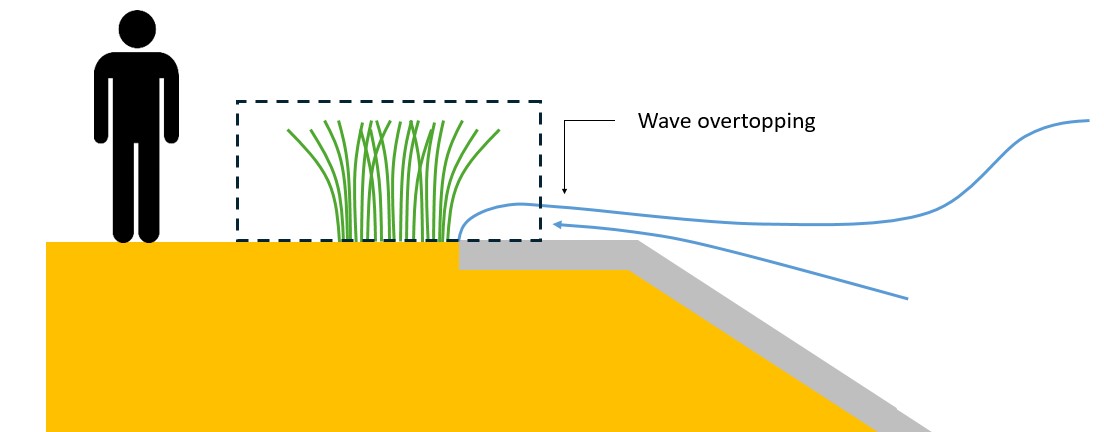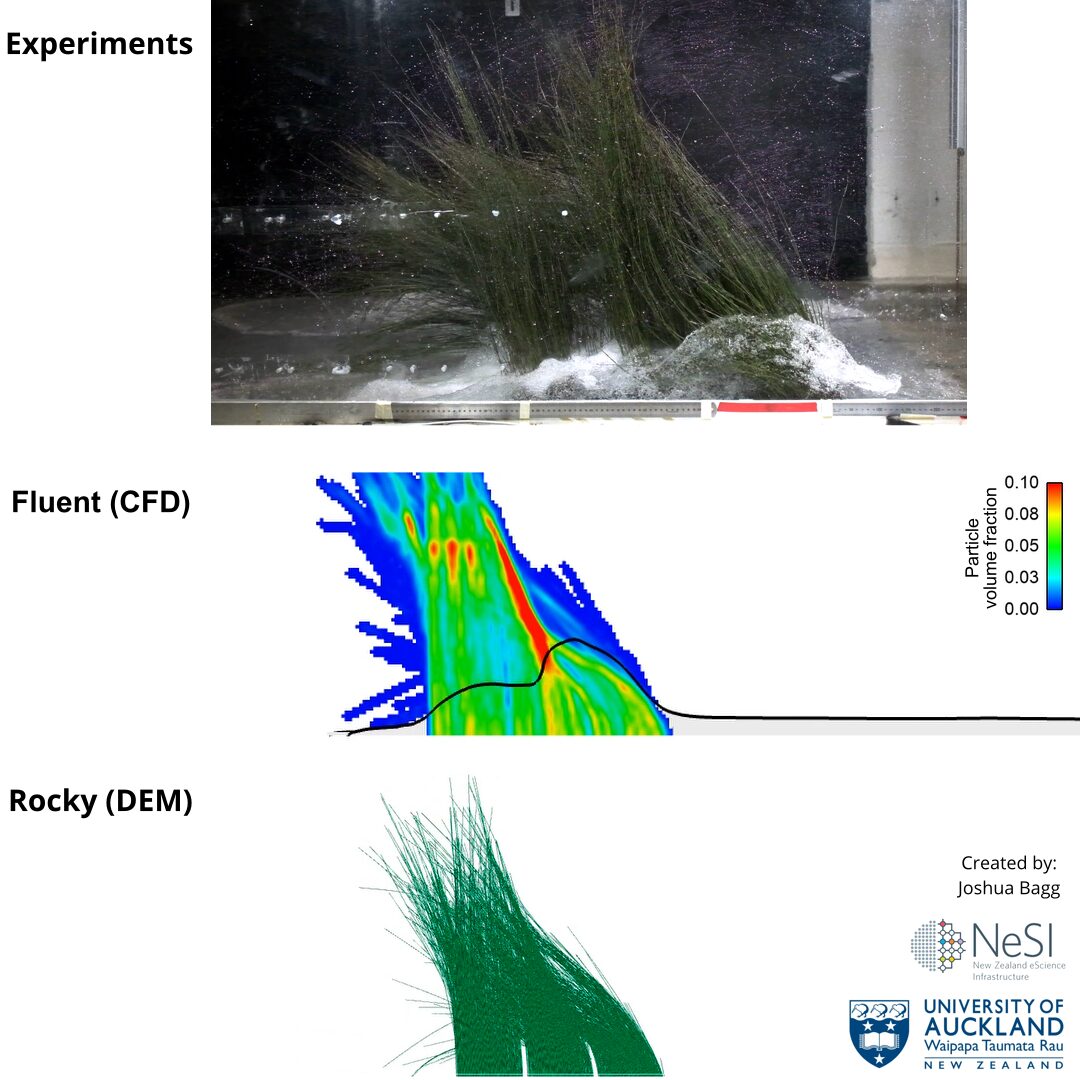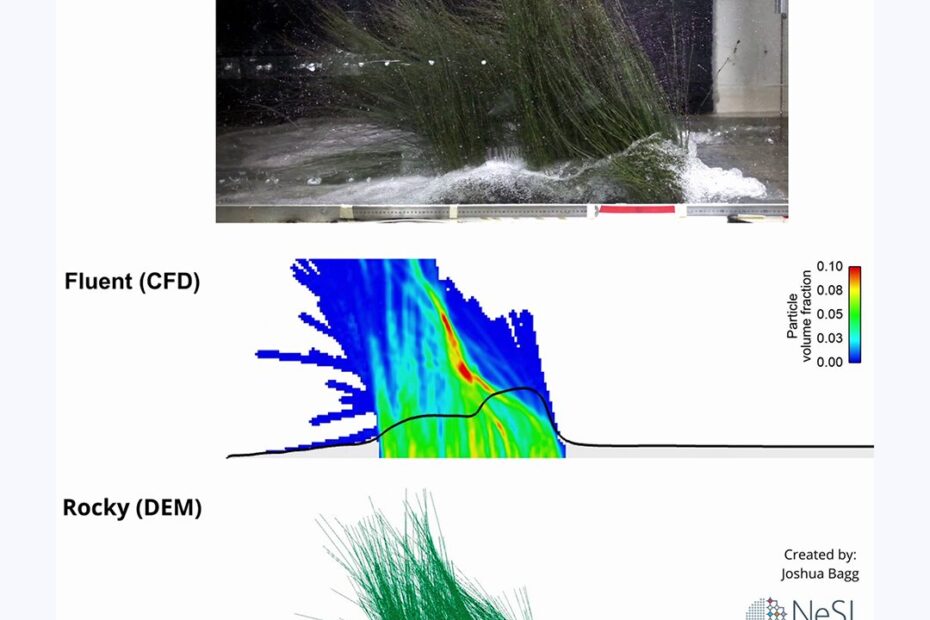Guest Blog by Joshua Bagg, University of Auckland and research colleagues.
Climate change is increasing the exposure of communities to coastal hazards [1 – 4]. Traditional solutions, such as seawalls or revetments, can have a high financial, social, and environmental cost [3, 5, 6]. As a result, nature-based solutions are encouraged in coastal policy [6 – 8]. A novel hybrid solution is salt marsh grass placed on the crest of a revetment (Figure 1), which has the potential to reduce the momentum of waves washing over the structure, mitigating wave overtopping hazards [9, 10]. However, the implementation of this novel hybrid solution, and nature-based solutions in general, is hampered by the lack of quantitative data, validated models, and technical design guidance [1, 3, 11, 12]. This is due to the challenges of representing live, flexible vegetation in numerical models and in scaled laboratory experiments. This research aimed to investigate the interaction between salt marsh grass and wave overtopping flow to inform the design of nature-based solutions.

Figure 1 – Diagram of salt marsh grass on the crest of a sloped revetment. The dashed region identifies the experimental and numerical modelling domain.
With human safety and high-value coastal assets at risk, coastal engineers need methods, results and design tools they can trust. Appropriately scaled laboratory wave-flume experiments are relied upon to assess coastal protection performance, as complex fluid dynamics can be accurately replicated. Therefore, live salt marsh grass was placed in a flume without geometric scaling and impacted by flow that represents non-impulsive overtopping waves (more details about the experiments are available in [10, 13]).
It is inevitable that coastal engineers will need to design for different overtopping flows or vegetation types than were tested in the experiments by Bagg et al. [10]. Additionally, there are many variables such as flow velocity, turbulence and aeration which are challenging to measure in the laboratory.
Numerical models can overcome these challenges but must first be compared with reality, to understand the model accuracy and limitations.
The two-way coupled CFD-DEM model methodology, using ANSYS Fluent and ANSYS Rocky, was identified to include the dominant physics required to simulate the fluid-structure interaction. Inspiration was taken from a Rocky simulation of a combine harvester [14], which shows Rocky’s ability to simulate many individually moving flexible fibers, large deflection, fiber-fiber contact and fiber breakage. Furthermore, Rocky allows two-way coupling with Fluent and GPU acceleration.
Thanks to the technical support from Angelo Christakakis at LEAP Australia, a stable Fluent-Rocky simulation was setup. An animation of the model results compared with the experimental results is shown in Figure 2.
Figure 2 – Comparison of experiments and Fluent-Rocky simulation results.
The Fluent-Rocky model accurately simulated the deflection of the live vegetation canopy. This is shown in Figure 3, at the instant of maximum canopy deflection. The Fluent-Rocky model can simulate each of the three FSI regimes, described as the emerged, transition and submerged regimes [10]. The emerged regime represents flow through a porous medium, resulting in a significant reduction in downstream flow momentum. In the submerged regime, the canopy deflects to a streamlined shape, which reduces the drag force on the canopy, resulting in minimal reduction in downstream flow momentum. The transition regime represents a complex combination of both flow through a porous medium and flow over a streamlined object. Fluent-Rocky can seamlessly simulate these different regimes, by only changing the inlet flow boundary condition. The FSI regimes are related to the downstream flow momentum and therefore the ability of the canopy to mitigate wave overtopping hazards [10]. Furthermore, measuring transient flow momentum in experiments is challenging but relevant variables can be output from Fluent with ease. This equips coastal engineers with a tool to both predict FSI regime and reliably measure downstream flow momentum.



Figure 3 – Comparison of experiments and Fluent-Rocky simulation results. From left to right, the FSI regimes are labelled as emerged, transition and submerged.
Another key benefit of Fluent-Rocky is that minimal model calibration was required. This is because the Rocky DEM flexible fiber was defined using material properties measured in the laboratory. This also enables coastal engineers to control vegetation properties in Rocky, allowing investigation of the wide range of vegetation properties that occur in nature.
Simulations were run using the New Zealand eScience Infrastructure (NeSI), with one NVIDIA A100 40 GB GPU allocated to Rocky and 32 logical CPUs allocated to Fluent. Using this hardware, the simulations shown in Figure 2 took 40-65 hours of wall clock time, per second of simulation time. This pace may be a barrier to uptake of this modelling methodology by industry, although GPU hardware performance is rapidly improving driven by significant investments in GPU computing for artificial intelligence and other HPC workflows. The opportunity exists to utilise multiple next-generation GPUs (such as NVIDIA Blackwell), and run multiple test iterations in parallel using cloud-computing infrastructure, which may ultimately achieve the rapid turnaround in results that are desired by industry.
To further reduce computational cost, different approaches to the modelling methodology can be considered. For example, the model domain in Figure 2 is 3D, 0.113 m wide, which simulates out-of-plane stem deflection and 3D flow patterns around clumps of stems that occurred in the experiments (see Fig. 6 of Bagg et al. [10]). If three-dimensional effects can be neglected, a narrower domain width such as 0.010 m may be used. Another approach could be representing multiple stems by a single stem. The Fluent-Rocky model could also be used to calibrate porous medium vegetation parameters in computationally efficient models such as XBeach-Veg [10]. Future research into modelling methodologies that reduce computational cost without compromising accuracy is encouraged.
In summary, climate change and the need for cost-effective and environmentally friendly coastal solutions are driving the demand for nature-based protection. However, designing for the interaction between flexible vegetation and wave impacts poses a variety of challenges. Engineers are required to draw knowledge across laboratory experiments, fieldwork and models, with each method having unique benefits and limitations. This research has provided experimental results and shown how Fluent-Rocky can contribute to the design of nature-based solutions.
For more information on the Fluent-Rocky methodology, validation, results, and limitations, follow Joshua Bagg’s LinkedIn for the release of future publications.
Research team:
Joshua Bagg – Department of Engineering Science, The University of Auckland
Mark Battley – Department of Engineering Science, The University of Auckland
Colin Whittaker – Department of Civil and Environmental Engineering, The University of Auckland
Tom Shand – Coastal Engineering, Tonkin + Taylor
References
[1] N. Burmeister and A. W. M. Pomeroy, “Working with nature – a practical approach,” in Australasian Coasts & Ports 2021 Conference, 2021.
[2] IPCC WGI, Climate Change 2021: The Physical Science Basis, Intergovernmental Panel on Climate Change, 2021. [Online]. Available: https://www.ipcc.ch/report/ar6/wg1/#SPM.1230
[3] R. L. Morris, T. M. Konlechner, M. Ghisalberti, and S. E. Swearer, “From grey to green: Efficacy of eco-engineering solutions for nature-based coastal defence,” 2018. [Online]. Available: https://doi.org/10.1111/gcb.14063
[4] R. Paulik, S. A. Stephens, R. G. Bell, S. Wadhwa, and B. Popovich, “National-scale built-environment exposure to 100-year extreme sea levels and sea-level rise,” Sustainability, vol. 12, 2020. [Online]. Available: https://doi.org/10.3390/su12041513
[5] R. L. Morris, A. Boxshall, and S. E. Swearer, “Climate-resilient coasts require diverse defence solutions,” Nature Climate Change, vol. 10, pp. 485–487, 2020. [Online]. Available: https://doi.org/10.1038/s41558-020-0798-9
[6] Department of Conservation, New Zealand Coastal Policy Statement, 2010. [Online]. Available: https://www.doc.govt.nz/documents/conservation/marine-and-coastal/coastal-management/nz-coastal-policy-statement-2010.pdf
[7] T. S. Bridges, J. K. King, J. D. Simm, M. W. Beck, G. Collins, Q. Lodder, and R. K. Mohan, “International guidelines on natural and nature-based features for flood risk management,” 2021. [Online]. Available: http://dx.doi.org/10.21079/11681/41946
[8] DAWE, National Climate Resilience and Adaptation Strategy 2021–2025: Positioning Australia to better anticipate, manage and adapt to our changing climate, 2021. [Online]. Available: https://www.dcceew.gov.au/climate-change/policy/adaptation/strategy/ncras-2021-25
[9] H. Blakely, Vegetation for wave overtopping mitigation: A laboratory and numerical investigation, Master’s thesis, The University of Auckland, 2023. [Online]. Available: https://hdl.handle.net/2292/66068
[10] J. Bagg, M. Battley, C. Whittaker, T. Allen, and T. Shand, “Salt marsh grass for reducing overtopped flow momentum: Experimental results and XBeach calibration,” Coastal Engineering, vol. 199, 2025. [Online]. Available: https://doi.org/10.1016/j.coastaleng.2025.104747
[11] M. Maza, “Experimental and numerical modelling of flow-vegetation interaction in the framework of nature-based solutions (NBS) for coastal defense,” in World Scientific, 2023, ch. 4, pp. 55–90. [Online]. Available: https://doi.org/10.1142/9789811284144_0004
[12] K. Ostrow, G. Guannel, E. L. Biondi, D. T. Cox, and T. Tomiczek, “State of the practice and engineering framework for using emergent vegetation in coastal infrastructure,” Frontiers in Built Environment, vol. 8, 2022. [Online]. Available: https://doi.org/10.3389/fbuil.2022.923965
[13] J. Bagg, M. Battley, C. Whittaker, and T. Shand, “Application of laboratory dam-break experiments to non-impulsive wave overtopping,” Coastal Engineering, vol. 198, 2025. [Online]. Available: https://doi.org/10.1016/j.coastaleng.2024.104695
[14] Rocky DEM Particle Simulator, “Combine harvester simulation | Prediction and comparison of operating and design conditions,” YouTube, 2021. [Online]. Available: https://www.youtube.com/watch?v=VTZ0LRnIZhU

